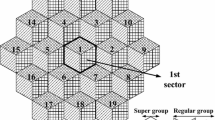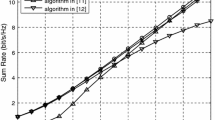Abstract
In multi-user OFDMA systems, adaptive resource allocation has been identified as one of the key technologies to have more flexibility and higher efficiency. Several adaptive subcarrier allocation algorithms with the objective to maximize spectral efficiency or fairness have been proposed. However, quality of service (QoS) requirement of each user may not be supported. Some algorithms considering user’s QoS requirement have been introduced, but they do not consider the case that every user’s QoS requirement cannot be guaranteed with limited resources. In this paper, we propose a maximum achievement rate allocation (MARA) algorithm as a new adaptive resource allocation algorithm. The proposed MARA algorithm has a goal to improve overall throughput while maximizing achievement rate, i.e., maximize the number of users meeting QoS requirements. In addition, we investigate that MARA is more effective when fractional frequency reuse (FFR) is adopted as a frequency partitioning scheme. Simulation results show that the MARA algorithm improves the achievement rate as well as overall throughput. Moreover, further performance gains are achieved when FFR is adopted.
Similar content being viewed by others
References
Schulze H., Lueders C. (2005) Theory and applications of OFDM and CDMA: Wideband wireless communications. Wiley, New York
Vizireanu D. N., Halunga S. V. (2012) Simple, fast and accurate eight points amplitude estimation method of sinusoidal signals for dsp based instrumentation. Journal of Instrumentation 7(04001): 1–11
Vizireanu D. N. (2011) A simple and precise real-time four point single sinusoid signals instantaneous frequency estimation method for portable DSP based instrumentation. Measurement 44(2): 500–502
Biagioni A., Fantacci R., Marabissi D., Tarchi D. (2009) Adaptive subcarrier allocation schemes for wireless OFDMA systems in WiMAX networks. IEEE Journal on Selected Areas in Communications 27(2): 217–225
Sadr S., Anpalagan A., Raahemifar K. (2009) Radio resource allocation algorithms for the downlink of multiuser OFDM communication systems. IEEE Communications Surveys & Tutorials 11(3): 92–106
Song G., Li Y. G. (2005) Cross-layer optimization for OFDM wireless networks—part I: Theoretical framework. IEEE Transactions on Wireless Communications 4(2): 614–624
Jang J., Lee K. B. (2003) Transmit power adaptation for multiuser OFDM systems. IEEE Journal on Selected Areas in Communications 21(2): 171–178
Xu, W, Zhao, C., Zhou, P., & Yang, Y. (2007). Efficient adaptive resource allocation for multiuser OFDM systems with minimum rate constraints. In IEEE International Conference on Communications (pp. 5126–5131).
Zhang Y. J., Letaief K. B. (2004) Multiuser adaptive subcarrier-and-bit allocation with adaptive cell selection for OFDM systems. IEEE Transactions on Wireless Communications 3(5): 1566–1575
Lee, J., Yoon, D., Jeong, W. J., Cha, K., Kim, E., Park, S. K. et al. (2007). Efficient subcarrier allocation for stable services in multi-user OFDM systems. In IST mobile and wireless communications summit (pp. 1–4).
Wang X., Giannaki G. B. (2011) Resource allocation for wireless multiuser OFDM networks. IEEE Transactions on Information Theory 57(7): 4359–4372
Sesia S., Toufik I., Baker M. (2009) LTE-the UMTS long term evolution. Wiley, New York
Dahlman, E., Parkvall, S., Skold, J., & Beming, P. (2007). 3G evolution: HSPA and LTE for mobile broadband. Academic Press: Oxford.
Kwan, R., Leung, C., & Zhang, J. (2009). Resource allocation in an LTE cellular communication system. In IEEE International Conference on Communications (ICC) (pp. 1–5).
Chung S. T., Goldsmith A. J. (2001) Degrees of freedom in adaptive modulation: A unified view. IEEE Transactions on Communications 49(9): 1561–1571
Goldsmith A. J., Varaiya P. P. (1997) Capacity of fading channels with channel side information. IEEE Transactions on Information Theory 43(6): 1986–1992
Choi J. G., Bahk S. (2007) Cell-throughput analysis of the proportional fair scheduler in the single-cell environment. IEEE Transactions on Vehicular Technology 56(2): 766–778
Rhee, W., & Cioffi, J. M., (2000). Increase in capacity of multiuser OFDM system using dynamic subchannel allocation. In IEEE vehicular technology conference (pp. 1085–1089).
3GPP, Huawei. (2005). Soft frequency reuse scheme for UTRAN LTE. R1-050507
Baum, D. S., Hansen, J., & Salo, J. (2005). An interim channel model for beyond-3G systems: Extending the 3GPP spatial channel model (SCM). In IEEE vehicular technology conference (pp. 3132–3136).
Ali S. H., Leung V. C. M. (2009) Dynamic frequency allocation in fractional frequency reused OFDMA networks. IEEE Transactions on Wireless Communications 8(8): 4286–4295
Author information
Authors and Affiliations
Corresponding author
Rights and permissions
About this article
Cite this article
Cho, TK., Oh, CY. & Lee, TJ. Maximum Achievement Rate Allocation Algorithm for Downlink Multi-User OFDMA Systems. Wireless Pers Commun 70, 1425–1442 (2013). https://doi.org/10.1007/s11277-012-0757-5
Published:
Issue Date:
DOI: https://doi.org/10.1007/s11277-012-0757-5




